2018 Top 5 Trends In Labeling
An exclusive article by Josh Roffman, Loftware VP Product Management
Globalization and digital technologies are changing businesses, especially as companies look to find new ways to amplify growth and expand into new markets. To do this, companies must create efficiencies in their supply chains and be able to keep up with complex and ever-changing supply chain dynamics. So, the question is - How has labeling changed with digital transformation and the new global supply chain model and how can labeling solutions meet the needs of today’s enterprise businesses?
It’s become clear that labeling plays an important role in creating new efficiencies both throughout the enterprise and within global supply chains. As business environments become more global and complex, companies need to look at labeling differently to keep pace with evolving technologies and to meet the demands of new multi-faceted, dynamic supply chains. Businesses that leverage innovation and embrace change and run their supply chains in a collaborative-fashion are the ones that will succeed in this new landscape. As always, businesses must be able to achieve high levels of agility, consistency, control and transparency to prosper. This is why it’s critical to identify, understand and measure how labeling has a strategic impact on your supply chain and your company’s business growth.
Trend 1: The Definition of Enterprise Labeling is Evolving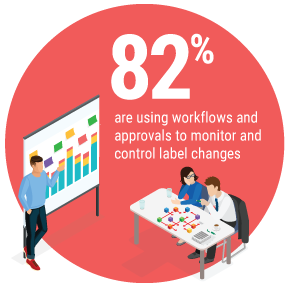
Labeling in today’s fast-paced global economy goes far beyond manufacturing, shipping and simple barcode labels. Today’s Enterprise Labeling offers a wide range of capabilities and benefits, providing dynamic data, content and artwork as well as the flexibility in labeling to meet all types of unique requirements in different industries and across global supply chains. As business demands continue to increase, companies are looking for Enterprise Labeling to become a central part of addressing new challenges that were addressed by adjacent yet separate solutions in the past. Companies are now seeing value in a holistic view of Enterprise Labeling as it converges with their requirements for complex workflow management, content management and artwork management.
Workflow and Approval Processes are Essential
As more stakeholders become involved in labeling and the importance of accuracy reaches new heights, workflow has become a vital component of enterprise labeling. Manual or disconnected workflow processes introduce additional cycle times and risk to the processes of reviewing and approving labels, content and artwork. Although our survey shows that as many as 82% of respondents are currently using workflows and approvals to monitor and control label changes, many of these processes are manual or not integrated directly within their enterprise labeling environment. Reducing cycle times on labels from months and weeks to days can represent a huge cost savings and increase agility when new products are introduced or major changes to labels are needed. Automating workflow within Enterprise Labeling is especially important for regulated industries such as Medical Device, Pharma, Food & Beverage, CPG and Chemical, where validation, traceability and compliance are essential.
Content Management is Critical
As the amount of content (data, translations, images, etc.) required for labeling and continues to increase, companies continue to struggle with the question of where that data should reside. Transactional and master data is most often sourced from ERP, WMS, SCM and PLM applications but many other elements that are used specifically for labels and packaging do not reside in these systems. However, these elements still need to be managed, reviewed and made available in real time for when labels are being printed. Our survey shows that 50% of respondents are integrating their labeling with some type of content management application. However, many companies are still struggling with content that resides in separate repositories or file systems that are not integrated into their enterprise labeling applications. This can make managing, reviewing and ensuring the accuracy of content difficult and even risky.
Enterprise Labeling and Artwork Management Converge
It is becoming clear there are many common requirements between labeling and artwork management and companies are looking for Enterprise Labeling to address the combined needs. This includes the ability to manage content including images, artwork, warnings, translations and phrases. It also means managing workflow and dynamically printing both labels and packaging artwork. The evolution of color print technologies and the move from pre-printed content via print houses versus on-demand printing is another important consideration. The demand for color labels has 48% of respondents expecting color to be even more prevalent in three years. At the same time, more businesses are looking to print product packaging and marketing materials onsite that have been traditionally outsourced. An integrated, unified approach increases agility and optimizes costs for companies looking to deal with customer, product, regulatory and regional complexities that impact both labeling and artwork management.
Trend 2: Centralized Control with Continuous Uptime is Imperative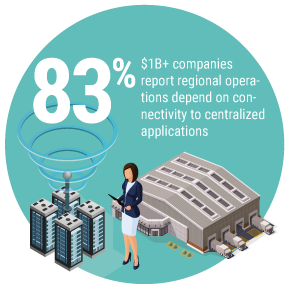
In the past, global companies needed to choose between deploying labeling systems centrally to maintain consistency and streamline management versus deploying locally to maximize uptime and reduce risk. This struggle is highlighted by the fact that 55% of 1B+ companies have concerns over the availability of centralized labeling applications which drive labeling at individual locations. Companies are looking to manage labeling centrally and ensure alignment with corporate standards while enabling geographically dispersed locations to run autonomously without relying on an uninterrupted connection to the “mother ship.” Enterprise Labeling now allows companies to realize the benefits of both centralized and decentralized deployments at the same time with new “multi-site” deployment capabilities. This approach offers the best of both worlds for companies that cannot allow a stop in mission-critical labeling but require greater control and consistency over global labeling.
Companies Require More Labeling Control and Consistency
Today’s companies are realizing that they can centralize and standardize with one Enterprise Labeling solution and still drive labeling from a range of local facilities. Fortunately, the advent of “multi-site” functionality enables centralization, empowering businesses to control labeling and make decisions centrally, while also meeting the demands of their localized facilities. Rather than manage multiple systems across different locations, this new breakthrough enables companies to streamline maintenance and ensure consistency while supporting enterprise-wide changes. This approach offers labeling consistency, helps support regulatory and standards compliance, enhances brand integrity, reduces costs and offers a single scalable solution that facilitates expansion to new global locations.
Business Continuity Demands Labeling Failover
Continuous labeling uptime is an absolute requirement. Almost all, 92%, of respondents said a stoppage in labeling causes operational disruption or production downtime. Additionally, 94% of 1B+ companies recognize the importance of maintaining continuous operations at the plant and/or manufacturing level. Despite its importance, achieving continuous uptime can be difficult for companies as nearly 83% reported that local operations depend on connectivity to centralized applications. The ability to have labeling continuity with failover from a central to a local instance is paramount in allowing remote locations to continue without disruption. The power of multi-site deployment capabilities enables labeling to fail-back to the central instance once the connection is re-established, then relevant transactional data can be synchronized between the central instance and any impacted facility.
Remote Facilities Look to Manage Labeling More Independently
In many cases, remote sites need to manage labeling with a degree of autonomy at manufacturing plants, contract manufacturer sites, warehouses, and distribution centers. These facilities often have location-specific nuances in labeling requirements that cannot be understood or managed by headquarters. As an example, production data is often location-centric, so manufacturing facilities need the ability to integrate with local data sources regardless of whether they are driving labeling centrally or, if a disruption occurs, locally. In this scenario, multi-site capabilities allow corporate to support regional deployments and ensure consistency while the remote sites get the location-specific autonomy they demand. This empowers facilities to run without depending on a full-time connection to headquarters while ensuring that they comply and stay current with corporate labeling standards. Ultimately, multi-site enables unlimited flexibility to standardize labeling across global supply chains.
Trend 3: Analytics is Bringing Improved Visibility into Labeling Processes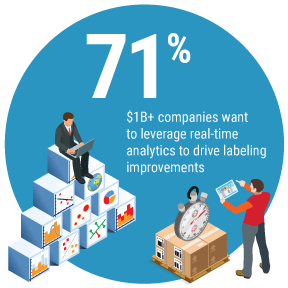
Companies today understand the value of obtaining important business metrics whenever and wherever you need them. For years now, companies have used Business Intelligence (BI) and reporting solutions with many of their enterprise applications to improve business operations. Given the mission-critical role of labeling, it’s only natural that business is expressing the growing need for advanced analytics and reporting from their enterprise labeling solution. This is especially true because labeling has a direct impact on production and supply chain investments. Our recent survey revealed that although a majority of companies don’t currently have BI for labeling, over 71% of $1B+ are interested in leveraging real-time analytics and reporting to help drive improvements to labeling solutions.
Taking Labeling One Step Further with Interactive Analysis
When it comes to labeling there has traditionally been limited reporting options to assess activities and drive efficiencies. However, companies are beginning to demand the tools needed to understand and optimize their labeling environment. Successful businesses are looking to go beyond simple reporting and leverage interactive dashboards so they can drill down to get specific insights into labeling trends and activities. They are seeking real-time visibility that enable them to make better labeling decisions and allow better planning, so they can quickly adapt to changing business scenarios and become more competitive.
Analytics are Driving Improvements to Labeling Processes
Visibility into labeling is enabling new levels of efficiency. When users have access to advanced analytics and real-time reporting they are able to gain visibility into constantly changing and vital information including labels, printers, print jobs, users and audit data. Users are looking to leverage analytics to drive improvements to labeling processes by asking questions like: Which printers are doing the most work? What labels are being printed the most? What label templates are not being used? How can I gauge the impact of my labeling efforts? Is there a more optimal way to route my print jobs? Who is making label changes? Administrators now want BI to monitor labels printed across facilities to make sure that the quantity of labels printed are in line with the expected output of a facility. They are also looking to use this insight to establish better maintenance schedules for printers and to analyze trends in label production to fine tune labeling environments.
Audit Reporting is Critical for Regulated Industries
Trend 4: Cloud Technology is Disrupting Labeling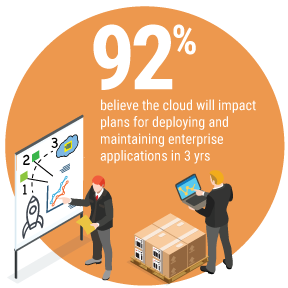
More than ever, businesses are embracing the cloud as a preferred deployment method for enterprise applications. Our survey showed that 45% of respondents report cloud technologies are impacting plans to deploy and maintain enterprise applications and 74% of $1B+ companies are leveraging private cloud technologies today. Not surprisingly, companies are also looking to integrate their labeling with their cloud-based enterprise applications and, in many cases, deploy their labeling solutions in the cloud. Cloud-based labeling simplifies maintenance and support, reduces cost and IT involvement and expands global use. However, cloud-based labeling must not sacrifice the flexibility and print performance that are both essential. This demonstrates the importance of deploying enterprise labeling solutions that are built for cloud deployments, including remote printing capabilities that use native print drivers to optimize printing from the cloud.
Cloud Deployment Offers Seamless Upgrades, Maintenance and Scaling
Businesses today are moving more of their IT infrastructures to the cloud to focus more on their core businesses, simplify maintenance, improve total cost of ownership and streamline their on-demand provisioning of hardware and software. Along with these benefits, cloud deployment also provides flexibility to scale, eliminates the need for extensive disaster recovery plans and facilitates automatic software updates. It’s clear that is a growing trend with 92% of respondents reporting that three years from now they believe cloud technologies will impact their plans for deploying and maintaining enterprise applications. This dramatic move to the cloud also impacts labeling as companies look for their enterprise labeling solutions to be both built for cloud deployment and able to integrate with other cloud-based applications.
Need for Certified Integration with Cloud-based Enterprise Applications
The titans of the enterprise application market, including SAP, Oracle, and Infor, as well as many others have fully embraced the cloud. Consequently, their customers are looking to determine how labeling will be addressed as they move from on premise deployments to cloud-based deployments. These customers understand the benefit of moving their business applications to the cloud but often fail to think about how labeling processes will be affected. Not surprisingly, businesses expect to be able to print the same labels they print today, with the same printers and the same performance. The challenge for companies is to find an enterprise labeling solution that is designed and certified to integrate with applications in the cloud (like S/4HANA, Oracle SCM Cloud or Infor CloudSuite) and to print from the cloud while meeting existing labeling requirements.
Native Print Drivers Needed for Increased Performance
Businesses have expectations for label printing performance based on their on-premise deployment of applications and their network of printers. Printing from cloud-based applications requires a different approach to ensure these expectations continue to be met as companies move to the cloud. Deploying an enterprise labeling solution designed for cloud printing using native drivers is essential to making these expectations a reality. By using native drivers, organizations reduce the size of their print streams delivered over the internet and dramatically increase print speed. The key here is to simplify the printing process, reduce the moving parts in the labeling solution and support a broad set of printers across locations. An enterprise labeling solution, which includes native printer drivers, reduces print streams to minimize network traffic, optimizes print performance and limits maintenance to meet high-volume print requirements.
Trend 5: Labeling Demands More Attention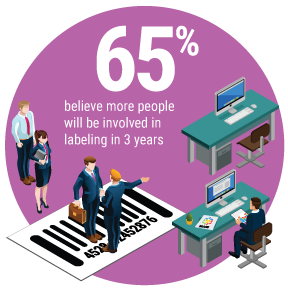
As labeling has become vital for global operations, many more people, groups, departments and regions are becoming involved in labeling. Each of these constituents have their own interests and requirements that must be appropriately represented on the label. For this to happen, individual departments need to collaborate across the enterprise to ensure accuracy, create efficiencies and streamline mass label changes. More than 68% of $1B+ companies surveyed indicated that there is a significantly increasing amount of people in their organization getting involved in labeling – a 42% increase from last year’s survey. Additionally, 65% of companies also believe they will have even more people involved in labeling in the next three years. These companies understand the advantage of coordinating labeling throughout their enterprise as an increasing number of stakeholders are getting involved in the labeling process. Our recent survey showed that the most common groups involved in labeling are from IT, Operations, Regulatory, Warehousing, Supply Chain, Manufacturing, Marketing and Sales.
Multiple Departments are Now Responsible for Labeling
With the number of corporate groups and people involved in labeling growing rapidly, it’s becoming increasingly important to have different stakeholder requirements addressed and managed. Organizations are looking to empower stakeholders in the labeling process and use “layers” to segregate and manage the real estate on a label. This enables better control and consistency over the label design process by allowing different groups (e.g. regulatory, marketing, product management) to “own” and control specific layers of a label to streamline approvals and mass updates. It also helps to distribute the workload and speed up label creation. The use of layers can also improve label consistency and accuracy, while reducing the time and effort needed to manage large numbers of label templates.
Globalization of Labeling Creates Added Involvement
As businesses extend their reach across the global supply chain, they are looking to standardize their labeling solutions and maintain labeling consistency. As a result, a centralized approach to labeling has become more important. However, each region has its own labeling requirements and resources involved in the labeling process. As companies scale, they must consider how to efficiently deploy and maintain labeling solutions while meeting the needs of stakeholders in multiple markets and regions. Part of that challenge is to understand and address the unique requirements in each market or region. And to streamline maintenance and support enterprise-wide labeling changes, businesses must be more proactive in designating resources with corporate-wide responsibilities to coordinate labeling across supply chains and global teams.
Regulatory and Customer Requirements Drive Labeling Involvement
Labeling has become more complex as companies must meet critical customer and regulatory labeling requirements, while maintaining labeling consistency across multiple markets. This proliferation of customer and regulatory requirements has resulted in more stakeholders getting involved in the labeling process and recently companies have taken strides to establish a dedicated labeling function. This role offers oversight to ensure that the business is adhering to both regulatory guidelines in each international region, while meeting unique customer demands throughout the company’s global supply chain. At the same time, this global labeling function ensures that designated roles and departments are responsible for supporting corporate brand standards, while minimizing the threat of mislabeling.
 Josh Roffman, Loftware VP Product Management
Josh Roffman, Loftware VP Product Management
Josh is Vice President of Marketing & Product Management at Loftware. He has nearly 25 years of marketing and product management experience with leading enterprise software companies. He is responsible for defining Loftware’s product strategy and overseeing all corporate marketing functions. Specializing in the impact of supply chain trends on enterprise labeling, Josh frequently speaks at industry events.
More great articles:
